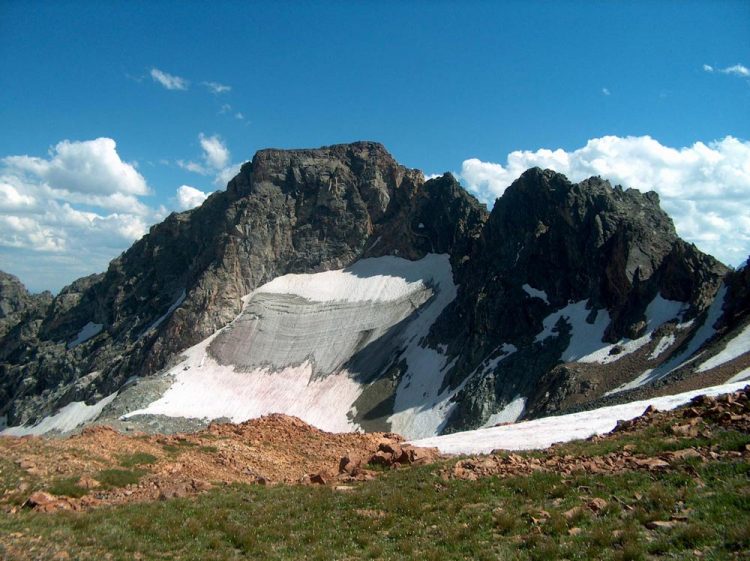Ancient rocks of Tetons formed by continental collisions

Rolling Thunder Mountain near Talus Lake is part of the Teton Range. The orange rock in the foreground is Webb Canyon gneiss, granite formed by decompression melting more than 2.6 billion years ago. Credit: Carol Frost
The research, published Jan. 22 in the journal Geochimica et Cosmochimica Acta, shows that plate tectonics were operating in what is now western Wyoming long before the collisions that created the Himalayas starting 40 million years ago.
In fact, the remnants of tectonic activity in old rocks exposed in the Tetons point to the world's earliest known continent-continent collision, says Professor Carol Frost of UW's Department of Geology and Geophysics, lead author of the paper.
“While the Himalayas are the prime example of continent-continent collisions that take place due to plate tectonic motion today, our work suggests plate tectonics operated far, far back into the geologic past,” Frost says.
The paper's co-authors include fellow UW Department of Geology and Geophysics faculty members Susan Swapp and Ron Frost.
The researchers reached their conclusions by analyzing ancient, exposed granite in the northern Teton Range and comparing it to similar rock in the Himalayas.
The rocks were formed from magma produced by what is known as decompression melting, a process that commonly occurs when two continental tectonic plates collide. The dramatically thickened crust extends under gravitational forces, and melting results when deeper crust rises closer to the surface.
While the Tetons are a relatively young mountain range, formed by an uplift along the Teton Fault less than 9 million years ago, the rocks exposed there are some of the oldest found in North America.
The UW scientists found that the mechanisms that formed the granites of the Tetons and the Himalayas are comparable, but that there are significant differences between the rocks of the two regions.
That is due to differences in the composition of the continental crust in Wyoming 2.68 billion years ago compared to crustal plates observed today. Specifically, the ancient crust that melted in the Tetons contained less potassium than the more recently melted crust found in the Himalayas.
The research was supported by the National Science Foundation.
Media Contact
All latest news from the category: Earth Sciences
Earth Sciences (also referred to as Geosciences), which deals with basic issues surrounding our planet, plays a vital role in the area of energy and raw materials supply.
Earth Sciences comprises subjects such as geology, geography, geological informatics, paleontology, mineralogy, petrography, crystallography, geophysics, geodesy, glaciology, cartography, photogrammetry, meteorology and seismology, early-warning systems, earthquake research and polar research.
Newest articles

Superradiant atoms could push the boundaries of how precisely time can be measured
Superradiant atoms can help us measure time more precisely than ever. In a new study, researchers from the University of Copenhagen present a new method for measuring the time interval,…

Ion thermoelectric conversion devices for near room temperature
The electrode sheet of the thermoelectric device consists of ionic hydrogel, which is sandwiched between the electrodes to form, and the Prussian blue on the electrode undergoes a redox reaction…

Zap Energy achieves 37-million-degree temperatures in a compact device
New publication reports record electron temperatures for a small-scale, sheared-flow-stabilized Z-pinch fusion device. In the nine decades since humans first produced fusion reactions, only a few fusion technologies have demonstrated…





















